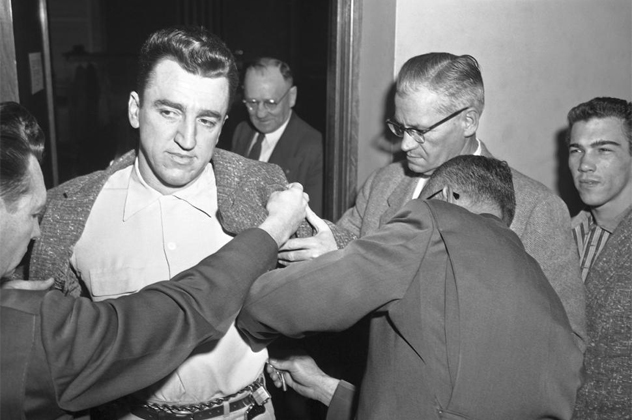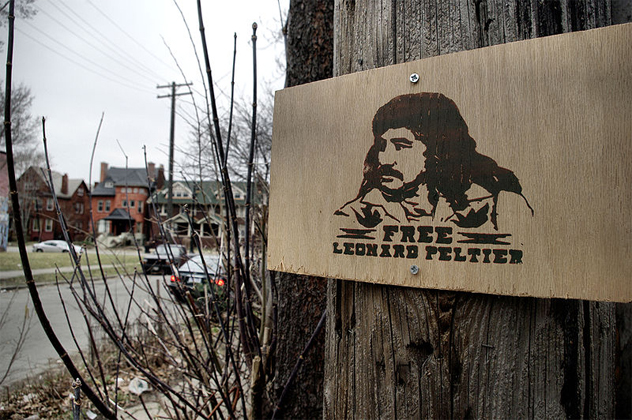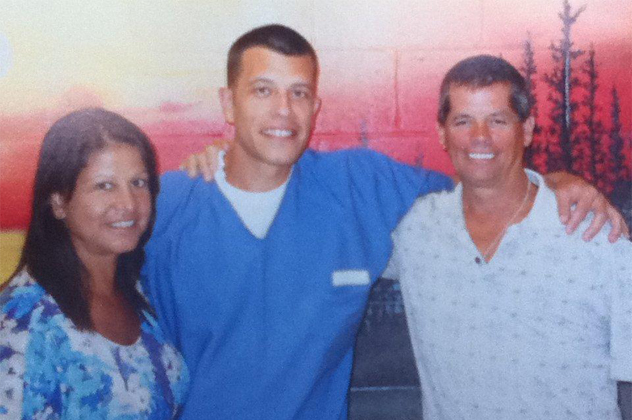 Weird Stuff
Weird Stuff  Weird Stuff
Weird Stuff  Mysteries
Mysteries 10 Tragic Disappearances and Deaths in Joshua Tree National Park
 History
History 10 Ways Childhood Really Sucked in the Old West
 Music
Music 10 Name Origins of Famous Bands from the 1990s
 Religion
Religion 10 Biggest Turnarounds by the Catholic Church
 Weird Stuff
Weird Stuff 10 Unbelievable Times Laws Had Unintended Consequences
 Humans
Humans Ten Historic Women Who Deserve Way More Credit Than They Got
 Movies and TV
Movies and TV 10 Films That Spawned Major Lawsuits
 History
History Ten Times Towns Were Wiped Off the Face of the Earth
 Creepy
Creepy 10 of the Most Disturbingly Haunted Public Houses in the UK
 Weird Stuff
Weird Stuff 10 Niche Subcultures That Are More Popular Than You Might Think
 Mysteries
Mysteries 10 Tragic Disappearances and Deaths in Joshua Tree National Park
 History
History 10 Ways Childhood Really Sucked in the Old West
Who's Behind Listverse?

Jamie Frater
Head Editor
Jamie founded Listverse due to an insatiable desire to share fascinating, obscure, and bizarre facts. He has been a guest speaker on numerous national radio and television stations and is a five time published author.
More About Us Music
Music 10 Name Origins of Famous Bands from the 1990s
 Religion
Religion 10 Biggest Turnarounds by the Catholic Church
 Weird Stuff
Weird Stuff 10 Unbelievable Times Laws Had Unintended Consequences
 Humans
Humans Ten Historic Women Who Deserve Way More Credit Than They Got
 Movies and TV
Movies and TV 10 Films That Spawned Major Lawsuits
 History
History Ten Times Towns Were Wiped Off the Face of the Earth
 Creepy
Creepy 10 of the Most Disturbingly Haunted Public Houses in the UK
10 Criminal Convictions Shrouded In Controversy
Throughout history, there have been numerous examples of innocent people who were convicted of a crime they did not commit. In the end, many of these wrongfully accused people were fully exonerated and had their names cleared. However, there are other stories where the full truth about what actually happened has never come to light. In these cases, there are divisive reactions about the guilt or innocence of the accused. The stories surrounding these crimes are often so bizarre or convoluted that it’s difficult to infer what really happened. The following people have never received exoneration for their alleged crimes and, while some of them may have been guilty and deserved their punishment, their convictions are still shrouded in controversy.
10David Rice And Edward Poindexter

At approximately 2:00 AM on August 17, 1970, the Omaha Police Department received an anonymous 911 call reporting a woman screaming at a vacant house. When police arrived at the house, there was no trace of any woman, but they did find a suitcase. They did not realize that the suitcase was rigged with a dynamite bomb. It soon went off, killing Officer Larry Minard. Shortly thereafter, 15-year-old Duane Peak was arrested. He confessed to making the 911 call and planting the bomb. He claimed that the bombing was a set-up orchestrated by Edward Poindexter and David Rice (who later changed his name to Mondo we Langa), leaders of the Omaha chapter of the Black Panther Party. They were charged with first-degree murder.
In exchange for being tried as a juvenile, which would allow him to be released at age 18, Peak testified against Rice and Poindexter at trial. They were both found guilty and given life sentences. However, since the Omaha Black Panthers were being investigated by the FBI at that time, some people believe that Rice and Poindexter were framed. Even though the prosecution’s entire case hinged on Peak’s testimony, there were numerous holes in his story. While some dynamite was found in Rice’s basement, he has always insisted that it was planted there.
Furthermore, the recording of the 911 call was excluded from the original trial and not disclosed to the defense team. It was eventually destroyed, but a copy surfaced years later. An audio forensics expert did an analysis of the recording and concluded that the caller was not actually Duane Peak. In spite of the controversy surrounding this case, all attempts to garner Rice and Poindexeter a new trial have failed, and they remain incarcerated.
9Caryl Chessman

During the 1940s, Los Angeles residents were terrorized by the “Red Light Bandit,” a man who approached parked cars and gained his victims’ trust by flashing a red light and pretending to be a police officer. He would then rob and sexually assault them. In 1948, the Red Light Bandit was identified as a career criminal named Caryl Chessman, who confessed to the crimes and was charged with robbery, kidnapping, and rape. Even though he never actually murdered anyone, Chessman was sentenced to death because of a statute called “Little Lindbergh Law.” According to the law, kidnapping with bodily harm was a capital offense. Since Chessman had moved some of his victims a short distance before raping them, a controversial decision was made to classify these crimes as kidnapping.
Chessman acted as his own attorney, claiming that he was innocent and that his confession to the crimes had been coerced under torture from the police. Chessman appealed his death sentence and managed to continually postpone his execution date for years. During this time, he became a best-selling author on death row and garnered a lot of notable supporters. They believed that a man who never committed murder should not be executed, and appealed for clemency.
On May 19, 1960, a federal judge from the California Supreme Court authorized a last-minute stay of execution for Chessman and ordered his secretary to phone San Quentin Prison. The only problem was that the secretary accidentally dialed the wrong number. By the time she finally got through to the prison, Chessman was already in the gas chamber and it was too late to save him. While Caryl Chessman’s claims of innocence have always been regarded as dubious, the general consensus is that he never should have been executed.
8Jeremy Bamber

In 1985, Nevill and June Bamber lived at White House Farm near the village of Tolleshunt D’Arcy in England. The couple’s adopted daughter, Sheila Caffell, also lived there with her six-year-old twin sons, Daniel and Nicholas. Their adopted son, Jeremy, lived nearby. During the early-morning hours of August 7, Jeremy contacted the police claiming that his father had phoned him to say that Sheila was going crazy with a rifle. When police showed up at the farm, they discovered that the entire family had been shot to death. Sheila’s body was found with a rifle up against her throat. Since she suffered from schizophrenia, the crime seemed like a murder-suicide.
But one month later, Jeremy’s girlfriend told police that he had confessed to hiring a hitman to murder his family. Authorities came to believe that Jeremy wanted to collect a substantial inheritance and had staged the scene to make it look like Sheila had killed them.
Jeremy and the alleged hitman were arrested, but the hitman had an alibi for the night of the murders and was released. When Jeremy’s cousins found a silencer inside a cupboard which appeared to have blood on it, this cast further doubt on Sheila being responsible. Jeremy was found guilty of the murders and sentenced to five life terms. However, the police investigation was filled with errors, and much of the evidence against Jeremy was faulty. It seemed unlikely that the police could have missed finding the silencer at the murder scene, leading to accusations that Jeremy’s cousins framed him to collect his inheritance. Additionally, the jury at Jeremy’s trial was not told that Nevill had called the police before his death to say his daughter had gone berserk.
The conviction remains highly controversial, but Jeremy Bamber has always maintained his innocence and continues to fight to clear his name.
7Tom Dula

In 1958, the Kingston Trio released a hit song called “Tom Dooley,” which was based on an old North Carolina folk ballad about a legendary murder case. After serving as a Confederate soldier during the Civil War, Tom Dula returned home to his native Wilkes County. Tom’s wife, Ann Foster Melton, was now married to another man, so Tom became romantically involved with one of Ann’s cousins, Laura Foster. On the morning of May 25, 1866, Laura left her home and mysteriously disappeared. Her decomposed body was later found in a shallow grave. She had been stabbed to death.
Word started spreading that Laura had been murdered because Tom and Ann had rekindled their love for each other. There were even unconfirmed rumors that Tom had killed Laura because she was pregnant and had given him syphilis. Tom was charged with Laura’s murder while Ann was charged as an accomplice.
Even though the evidence against him was very circumstantial, Tom was convicted and hanged on May 1, 1868. The day before his execution, Tom wrote a note taking full responsibility for the murder, so Ann was acquitted at her trial. However, there are many who believe that Tom Dula was innocent and took the fall to protect Ann. According to Ann’s cousin, Pauline Foster, Ann showed her where Laura’s body was buried before it was found. Legend has it that Ann even confessed to the murder on her deathbed.
In 2001, the citizens of Wilkes County signed a petition to exonerate Tom Dula. It was sent to the Governor of North Carolina, but had no legal weight. As far as the history books go, Tom Dula is still considered a murderer.
6John Branion

John Branion was a prominent Chicago doctor who was very active in the civil rights movement and who served as personal physician to Martin Luther King Jr. On December 22, 1967, Dr. Branion left the hospital where he worked and picked up his son from school before heading home. When Branion entered his house, he was shocked to discover that his wife Donna had been shot to death. Since Branion was known for having extramarital affairs, he became the prime suspect. There were four shell casings at the scene, and a Walther PPK which Branion owned was missing. When four bullets were discovered to be missing from a box of ammunition in Branion’s closet, he was charged with his wife’s murder and put on trial.
Since only about 20 or 25 minutes passed between when Branion left the hospital and when he discovered his wife’s body, his defense team contended that there wasn’t enough time for him to drive home and murder his wife before going to pick up his son. In spite of a seemingly airtight alibi, Branion was found guilty. While out on bond appealing his sentence, Branion fled the country. He spent a few years hiding out in Uganda and even acted as personal physician to Idi Amin.
In 1983, Branion was finally captured and extradited back to the United States, where he began serving a sentence of 20 to 30 years. Branion continued fighting for his freedom, especially after he developed a brain tumor and a heart ailment. In 1990, the terminally ill Branion had his sentence commuted to time served and was released just in time to pass away one month later. While it seems unlikely that Branion could have committed the murder himself, some do not discount the possibility that he hired someone to kill his wife.
5Leonard Peltier

On July 26, 1975, FBI agents Jack Coler and Ronald Williams went to the Jumping Bull compound at the Pine Ridge Indian Reservation in South Dakota to question a suspect. The two agents soon radioed for backup after coming under fire from the compound. By the time reinforcements arrived, Coler and Williams had been shot and killed. After a shootout between the FBI and members of a Native American advocacy group called the American Indian Movement, four suspects were indicted for the murders of Coler and Williams, including a Native American activist named Leonard Peltier. Peltier became a fugitive and fled to Canada before he was extradited two years later. In 1977, three of the original suspects were acquitted, but Peltier was found guilty of the murders and given two consecutive life sentences.
However, Peltier’s conviction remains highly controversial, as many believe he did not fire the fatal shots into the two agents. Over the years, he has garnered many notable supporters, including Nelson Mandela, the Dalai Lama, and Robert Redford. They believe that the evidence against Peltier was flawed, as three witnesses who named him as the shooter recanted their testimony, claiming that it had been coerced by the FBI. Before he died, one of the acquitted suspects, Bob Robideau, allegedly confessed to firing the shots into Coler and Williams.
The consensus seems to be that even if Peltier did pull the trigger, there was no way to prove this beyond a reasonable doubt. In spite of the controversy, Peltier’s supporters have been unable to overturn his conviction. He is still incarcerated.
4Eliza Fenning

In 1815, 21-year-old Eliza Fenning worked in the London household of a law clerk named Orlibar Turner. On the evening of March 21, Fenning prepared some yeast dumplings for Turner, his son, and his daughter-in-law. A housemaid and two apprentices also ate the dumplings, but shortly thereafter, everyone became violently ill with stomach cramps and vomiting. Eliza Fanning also became ill, but not as violently as the others. In the end, everyone made a full recovery, but John Marshall, a surgeon who attended to the patients, became convinced that their illness had been caused by consuming white arsenic. Since Fenning was the only person who had prepared the dumplings, he believed that she intended to poison her employers. Fenning went on trial for attempted murder.
The prosecution alleged that Fenning took a small bite of the dumplings in order to detract suspicion from herself, which is why she became less ill than the others. Marshall’s expert testimony was enough to convict Fenning, and she was sentenced to death. She never stopped proclaiming her innocence, though, even when she was hanged on June 26. At the time, toxicology was still in its infancy, and as the years went on, medical experts came to believe that the forensic evidence used to convict Fenning was highly flawed.
Marshall had demonstrated how Fenning baked arsenic into the dumplings, but if Fenning actually followed this method, she would have used 1,800 grains of poison. Since five grains are enough to be fatal, there’s no way any of the victims would have survived. If arsenic was used, it was more likely to have been sprinkled on the dumplings after they were prepared—and anyone in the household could have done that. There is now much doubt that Eliza Fenning was the real culprit.
3Ryan Holle

On the morning of March 10, 2003, 20-year-old Pensacola, Florida resident Ryan Holle was recovering from a night of partying when his roommate, William Allen Jr., asked to borrow his car. Holle agreed, so Allen used Holle’s car to drive Charles Miller Jr. and two other accomplices to a nearby house, where they intended to rob a local drug dealer at gunpoint. Miller and his accomplices went inside and proceeded to steal a pound of marijuana and $425. Miller then decided to murder the dealer’s 18-year-old daughter, Jessica Snyder, by bludgeoning her to death with his shotgun. It wasn’t long before all four of the perpetrators were sentenced to life imprisonment for the crime. However, because he lent his car to them, Ryan Holle wound up being imprisoned as well.
The state of Florida contains a legal doctrine called the “felony murder rule.” Even if someone does not actively participate in a murder, they can still be held liable if they contributed to it in any way. The prosecution argued that the murder of Jessica Snyder would not have been possible if Ryan Holle had not provided the perpetrators with his vehicle. Holle turned down a plea deal of 10 years and wound up receiving a sentence of life without the possibility of parole.
The biggest source of controversy is whether or not Holle knew his vehicle was going to be used for the purposes of committing a crime. Even though Allen had implied that a burglary was going to take place, Holle claimed that he thought Allen was joking and was too hungover to take him seriously. Since Holle had no criminal record prior to the incident, many believe that a life sentence is too severe a punishment for the simple act of lending out a vehicle.
2Alger Hiss

On August 3, 1948, a former Communist Party member named Whittaker Chambers testified in front of the House Committee on Un-American Activities (HUAC). He claimed that a prominent government official named Alger Hiss had also been a Communist. Hiss responded by filing a defamation lawsuit against Chambers and then appeared in front of the HUAC to deny the allegations. One of the HUAC members, an ambitious congressman named Richard Nixon, decided to pursue the case against Hiss. Chambers eventually produced evidence that both he and Hiss had been involved in espionage and that Hiss was a Soviet spy. By this point, the statute of limitations for charging Hiss with espionage had expired, but since Hiss had denied committing espionage while under oath, he was charged with two counts of perjury.
The prime evidence against Hiss was a series of State Department notes known as the “Baltimore documents” containing state secrets that Hiss had allegedly passed to the Soviets. Some of the documents appeared to be in Hiss’s handwriting, and others were matched to a specific brand of typewriter he owned, but Hiss claimed that they were forgeries. Chambers also produced a microfilm known as the “Pumpkin Papers,” which he kept hidden inside a hollowed-out pumpkin on his farm. This microfilm also contained classified State Department documents which Hiss had allegedly passed to the Soviets.
After Hiss was indicted, he was found guilty on January 25, 1950 and sentenced to five years in prison. The conviction would provide a big boost for Richard Nixon’s political career. In 1954, Hiss was granted an early release. He maintained his innocence and unsuccessfully fought to clear his name until his death in 1996. To this day, there is compelling evidence to both support and dispute the assertion that Alger Hiss was a Soviet spy, but the full truth remains a mystery.
1Nicola Sacco And Bartolomeo Vanzetti

On April 15, 1920, two guards were transporting boxes containing the company payroll to the Slater-Merrill Shoe Company factory in Braintree, Massachusetts. They were soon held up by two men, who shot them to death before stealing the boxes and making off with a haul of $16,000. The investigation soon led to Nicola Sacco and Bartolomeo Vanzetti, two Italian immigrants who were already under the watchful eye of law enforcement for being anarchists. Sacco and Vanzetti were both charged with robbery and first-degree murder and would be found guilty and sentenced to death in July 1921. However, this case would prove to be one of the most controversial convictions of all time.
The Sacco-Vanzetti Defense Committee was formed to appeal the convictions of both men, as they were believed to be victims of anti-Italian prejudice. Sacco and Vanzetti allegedly had alibis on the day of the robbery—witnesses placed them in other locations while the murders were taking place. A career criminal named Celestino Medeiros confessed that his gang was responsible for the Braintree heist and claimed that Sacco and Vanzetti were not involved. The strangest element of the case is the inconsistent ballistics evidence. While one of the bullets fired into the victims did match Sacco’s gun, the other three bullets did not. This contradicted eyewitness claims that all four bullets had been fired from the same gun.
By 1927, Sacco and Vanzetti had acquired a huge following of supporters who fought for their exoneration. Even though they were granted stays of execution, all attempts to secure them a new trial failed. Despite much protest, the original verdict was upheld and they were both executed in the electric chair on August 23. Debate about Sacco and Vanzetti’s guilt or innocence continues to this very day.
Robin Warder is a budding Canadian screenwriter who has used his encyclopedic movie knowledge to publish numerous articles at Cracked.com. He is also the co-owner of a pop culture website called The Back Row and recently worked on a sci-fi short film called Jet Ranger of Another Tomorrow. Feel free to contact him here.




